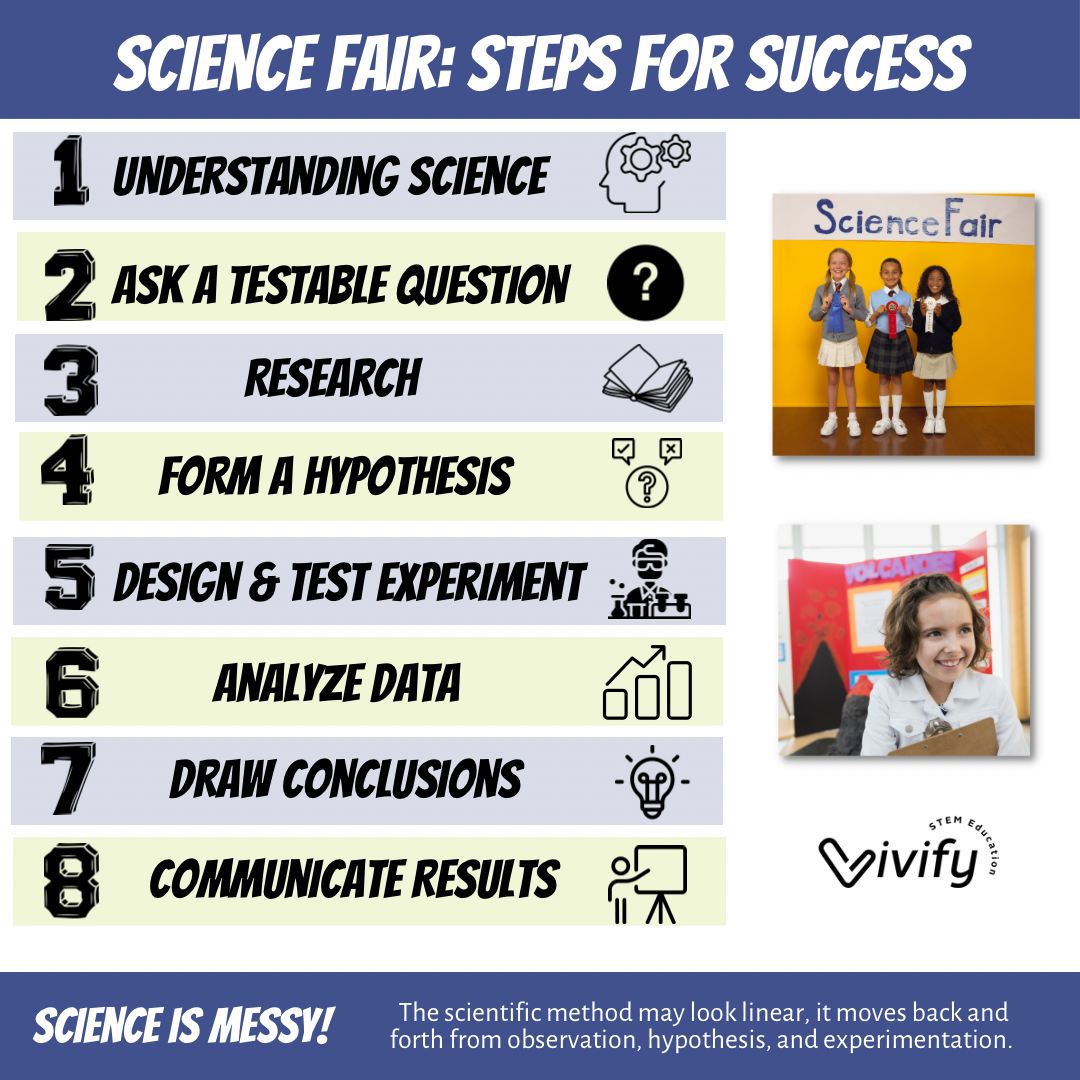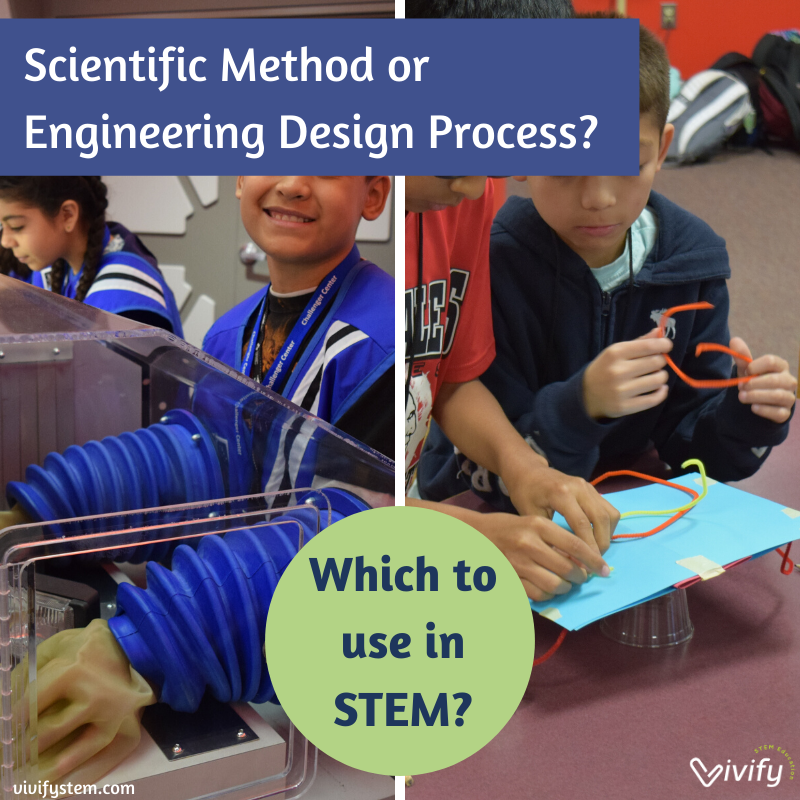A Teacher’s Guide to Science Fairs
Post by Michelle Bogden & Dr. Natasha Wilkerson
Originally Posted: August 1, 2023
Updated: July 2025
Are you a teacher responsible for running Science Fair this year? Not sure where to start? Read on for our Science Fair Guide: Steps to Success! This post includes the basics of Science Fair, our steps to success for teachers, free science fair posters, a nature of science lesson, and real student Science Fair project examples.
What is a Science Fair?
From the impact of music on plants to designing a water filter, a science fair project is generally student-driven scientific inquiry that develops science process skills and deepens an understanding of the scientific process. Check out this trailer of a movie all about Science Fair!
In a science fair, students typically choose a topic of interest, formulate a scientific question or hypothesis, and conduct experiments or research to find answers or solutions. The projects can cover various fields of science, such as biology, chemistry, physics, earth sciences, environmental studies, and more. Engineering design is also commonly included in Science Fair competitions.
For example, maybe a student is curious to know why some flowers in their backyard grow taller than others. They can set up an experiment to see how changing the location, amount of water, sunlight, and other factors impact the height of plant growth. The complexity and number of tested variables will vary across projects, allowing you to easily differentiate as needed. This is just one of the many benefits of hosting a science fair for your classroom or school!
Steps to Success
First, a word of warning. The process of science is messy! Although the scientific method may look linear, it moves back and forth from observation, hypothesis, and experimentation. This may feel a bit chaotic at times, but allowing students to take the lead will increase their confidence, understanding, and engagement in science! Here are the general steps to complete a science fair project:
Understanding science: how does it work?
Asking a testable question and forming a hypothesis
Reading scientific literature and pulling information related to the chosen topic
Synthesizing the information to form a hypothesis
Creating and conducting an experiment to test the hypothesis
Gathering data and representing the data in a graph
Generalizing and analyzing data to form a conclusion
Communicating the project and research to a scientific community
Click here to grab a free version of the Science Fair: Steps for Success poster for your classroom! You can also check out our complete teacher’s guide to running science fair and other resources below.
Nature of Science
During a science fair project, students will certainly improve science process skills like making observations, collecting data, and providing evidence for claims. However, will students really understand the scientific process?
As outlined above, the process in a classroom will involve setting up a hypothesis, conducting an experiment, analyzing the results, and learning about the natural world. However, the reality of science is much more complex! We love this flowchart by the University of California Museum of Paleontology that describes “real” science as iterative and does not follow a linear or predetermined path.
To avoid misconceptions about the scientific process, we encourage teachers to actively teach students about the nature of science. Here are more resources:
Think Like a Scientist Activity
You can introduce the Nature of Science in your classroom with our Think Like a Scientist activity. Here is how we run it in our classroom as a 5E unit:
Engage: What is in the Box?
Students engage in a decontextualized activity to try to guess a mystery object in the box using only yes or no questions. A class discussion will help students start thinking about the importance of good questions and how more evidence leads to a change in ideas.
Explore: Mystery Box
Build from the engage activity to investigate what is inside a mystery box using a set of tools. Creativity is key here! Students will start to recognize there are many methods for doing science and gathering evidence.
Explain: Think Like a Scientist
Build from exploration to conceptual understanding by introducing science connected to their experience with the mystery box. Students observe photos of natural phenomena and generate questions they are curious about while observing the photos. Science often starts with a question!
4. Elaborate: Design an Experiment
Have students generate a question about a natural phenomenon and then design a possible way to answer their question. Share results with the class. Notice how different questions require different ways to gathering evidence.
5. Evaluate: There is No Single Way to Do Science!
Continually assess students’ understanding and ability to reach learning goals and key concepts. Click below for the teacher guide that includes questions to use throughout the lesson.
Engineering Vs. Science
Schools often incorporate engineering design into a traditional Science Fair. However, each has very different goals and frameworks, and we recommend focusing on one if implementing it with a large class. Below, we outline how the scientific method and engineering design process are different but interconnected. You can read more on our blog post here.
Competition Timeline
The timeline for Science Fair is flexible and dependent on the teachers goals for the project.
Option 1: Class Project
Option 2: Host a Science Fair for the School Community
Option 3: Advance Students to Competitions
Below is a timeline we use in our classroom:
Joining a Science Fair Competition
There are many science fairs held locally, nationally, and internationally for students to participate in. If this is your intention for Science Fair, it is important to look for local fairs and review dates and deadlines for competitions in your area BEFORE beginning the Science Fair process. Each state will run this process differently. Some competitions may have students advancing to other competitions by receiving certain awards, while other competitions may be open to all students.
Highest Level of Competition:
6th - 8th grade: Broadcom MASTERS: The premier science competition for U.S. middle school students. The top 10% of students from local nominating science fairs compete at successive levels. Twenty-five finalists gather in Washington D.C. during the fall for unique STEM experiences and to compete for cash prizes. Local nominating fairs can be found at Society for Science.
9th - 12th grade: ISEF Competition: The Regeneron International Science and Engineering Fair (Regeneron ISEF) is the world’s largest international pre-college science competition. Each year, ISEF brings over 1,800 high school students from 75 countries to exhibit and demonstrate ingenuity and innovation through science projects of their own design. To compete at ISEF, a 9th-12th grade student must first win the honor through participation at a Society-affiliated fair. Each affiliated fair has a designated number of projects (individual or team) that they may support to come to ISEF. Find Affiliated Fairs here.
Ready to Get Started?
Hopefully, these resources give you a jump start on launching Science Fair with your students! We also invite you to click here for our free Science Fair posters (like the one below) that also include links to real student science fair project report examples.
Are you a STEM teacher? Confused on what process to use in your classroom?
Or perhaps you need a refresher on the scientific method versus the engineering design process. Read on for an overview of each, how they are used in the real world, and our view of which process is best for STEM education.








